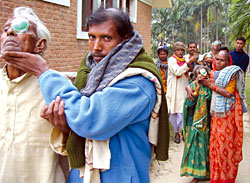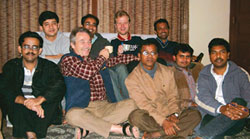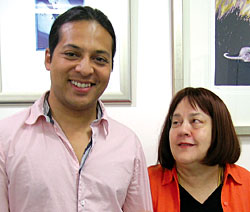 Baleswor Sharma, 73, of Barauni in Bihar gave up on ever being able to see again.
Baleswor Sharma, 73, of Barauni in Bihar gave up on ever being able to see again.
He suffers from cataract and has been blind for the last two years. He went to doctors in India but they made him run around in circles taking expensive tests. "Then I heard about this eye hospital in Nepal so that is why I am here," says the frail-looking man who travelled for a week to cross the border and reach Lahan. "They say if I can't see after being operated here, I will never see again."
In the early 1980s, the UN's World Health Organisation in Nepal (after a survey) decided that the tarai was the region most in need of an eye hospital. In 1982, Sagarmatha Choudhary Eye Hospital (SCEH) was set up in Lahan with the support of Germany's Christoffel Blindenmission (CBM) and Nepal Netra Jyoti Sangh.
It had only 12 beds then but today it is the second largest eye hospital in the world. It spreads across 7.4 hectares has 550 beds, five operating theatres with a total of 20 tables and its doctors perform 55,000 operations annually. SCEH has also established a reputation for affordable and high quality service.
Early in the morning, hundreds of patients line up with family members at their sides to register. In the afternoon, their vision and blood pressure are checked, sugar level tested and the doctors determine if they need surgery. The majority of operations here are cataract surgeries, performed in simple operating theatres furnished with what looks like basic equipment. At the same time, the patient spends no more than 10 minutes in the theatre.
"It is a hospital for the poor, everyone is treated equally and we never turn anyone away," says administrator Bindeswor Mahato. A cataract surgery including medicine, lens and bed costs Rs 900. Patients can pay more for a better ward but the medical costs don't change. There are no nurses at SCEH because family members take care of patients. Last year the hospital performed 2,550 surgeries that were subsidised or free. The hospital also has facilities of counselling for those who are incurably blind.
About 90 percent of patients come from northern India, most of them after the Chhat festival in November or in February. The hospital is easily accessible to 82 million people who live in neighbouring Bihar where word of mouth has made it more well known than in parts of Nepal. On a busy day in peak season, ophthalmologists perform up to 250 surgeries."People say that we are only providing service to non-Nepalis," admits manager Kristina Hennig, "but we are also operating on a large number of Nepalis."
SCEH doctors also travel across Nepal to hold cataract-screening camps and bring them to Lahan or a satellite hospital in Malangwa if they need surgery. The paediatric department examines children at the hospital and the camps. Unlike other hospitals, SCEH also has a lodge where family members of patients can stay and cook. Travel agents in Bihar now have fixed-rate cataract package tours for Indian patients to Lahan, which include cataract screening, transportation and food and the surgery fee. This little known start to Nepal's medical tourism brought in 7,000 patients last year.
Baleswor Sharma emerges from surgery and the doctors say he will see when his bandages come off. "it was surprisingly quick, I will recommend this hospital to my villagers."
Wanted: Nepalis
 It's not just Indian patients that outnumber Nepalis in Lahan, it is also the doctors. Of the 10 ophthalmologists now working at SCEH, eight are from India. Like Debajit Ray, a young ophthalmologist from Kolkata. "Operating on so many people every day is challenging and unique and it is also what I appreciate most about the place," says Ray.
It's not just Indian patients that outnumber Nepalis in Lahan, it is also the doctors. Of the 10 ophthalmologists now working at SCEH, eight are from India. Like Debajit Ray, a young ophthalmologist from Kolkata. "Operating on so many people every day is challenging and unique and it is also what I appreciate most about the place," says Ray.
In fact, the biggest challenge is attracting Nepali ophthalmologists to train and getting them to stay in Lahan. "It is so difficult to get Nepali ophthalmologists who want to work for us long-term because we are literally in the middle of nowhere and lack many facilities that cities offer," says Program Director Albrecht Hennig.
SCEH is now planning a 50-bed branch hospital in Biratnagar which should take some of the load off Lahan, encourage more Nepali doctors to work, and treat more Nepali patients.
Australians, too
 Suman Thapa, a Nepali eye specialist, has got together with Australian Kae Walls to treat glaucoma patients in Nepal. Glaucoma is a condition where the pressure within the eyeball exceeds the level that can be normally tolerated by the eye and can result in blindness. "It is the second largest cause of blindness in Nepal," says Thapa.
Suman Thapa, a Nepali eye specialist, has got together with Australian Kae Walls to treat glaucoma patients in Nepal. Glaucoma is a condition where the pressure within the eyeball exceeds the level that can be normally tolerated by the eye and can result in blindness. "It is the second largest cause of blindness in Nepal," says Thapa.
With a small support team in Melbourne, Kae Walls has raised $ 50,000 to begin construction on a glaucoma clinic at Tilganga in Kathmandu. Nepal Glaucoma Eye Clinic Association (NGEC), based in Melbourne, is raising the money which will be directly used to build the clinic and to hold various eye camps around the country. This new glaucoma clinic will be an addition to other services at Tilganga, a world-renowned centre of excellence in eye surgery.
Walls, a glaucoma patient herself, says her personal understanding of the disease prompted her to establish the clinic in Nepal.
Suvecha Pant in Sydney


